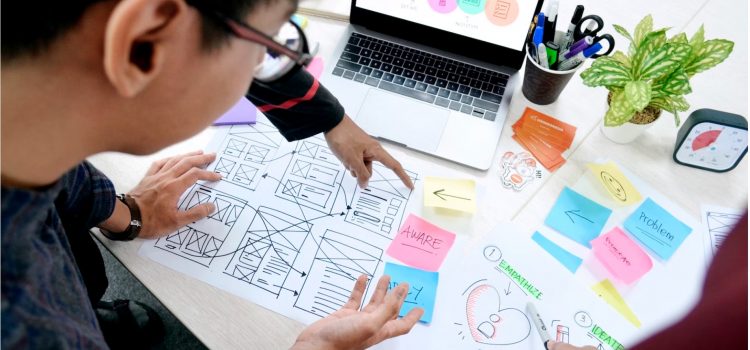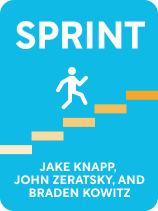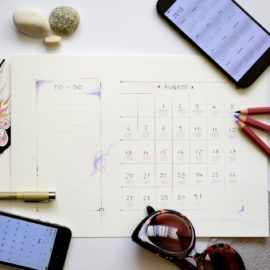

This article is an excerpt from the Shortform book guide to "Sprint" by Jake Knapp, John Zeratsky, and Braden Kowitz. Shortform has the world's best summaries and analyses of books you should be reading.
Like this article? Sign up for a free trial here.
Wondering how to define sprint goals? What is the sprint design process? How do you choose high-priority goals?
The Design Sprint process involves creating many versions of the same idea and improving your idea using the information you gain from each iteration. According to Jake Knapp’s book Sprint, design thinking can be broken down into two parts: identifying a problem and developing a solution (i.e. your sprint goal).
Read on to learn Knapp’s advice on how to define sprint goals, including a brief exercise at the end of the article.
Jake Knapp’s Design Sprint
Do you have an idea for a product, but you’re not sure how to turn it into a testable prototype? Maybe you’re not even sure it’s worth pursuing at all. Well, using Jake Knapp’s Design Sprint process, you can build and test prototype products within a five-day work week. Using Knapp’s advice on how to define sprint goals will help you to determine your idea’s viability quickly and cheaply.
Jake Knapp invented the Design Sprint process while working for Google. After moving to Google Ventures (GV), he facilitated sprints with over a hundred companies, including Slack, Airbnb, and Spotify. Designers John Zeratsky and Braden Kowitz collaborated with Knapp at GV to refine the process, and Zeratsky and Knapp later co-authored a book on time management, Make Time. All three are experts in efficiency, productivity, and team improvement strategies.
(Shortform note: At its most basic level, a Design Sprint is a set amount of time in which a team works on a set of tasks to create a testable version of a product. Sprints gained their name due to their short duration and the high intensity of the work involved.)
Day 1: Defining Your Sprint Goals
Knapp, Zeratsky, and Kowitz suggest first identifying a goal for your project and the questions you want your sprint to answer. You’ll also plan a customer’s experience with your product, from their first encounter with it through the full process of using it.
The authors say to start off Monday by deciding on a sprint goal with your team. It can be as broad and lofty as you want. When defining your sprint goal, think about the purpose of your project and what you hope it will achieve in the near and distant future. The information you learn from your sprint will help you progress toward this long-term aspiration.
For example, say there’s a team from a bookstore who are using their sprint to develop a prototype for a personalized book recommendation feature on their website. Their broader, long-term goal is to create a personalized online retail experience for their customers. Creating a successful recommendation tool would be one step toward reaching that goal.
(Shortform note: Other authors also advise starting the development process with clear goals for your product’s future. Marty Cagan (Inspired) calls this your “vision” in his product discovery process. To create a strong vision for your product, he suggests defining a clear “why”: You need to articulate why you think your product will be successful. Additionally, don’t be afraid to dream big. If your vision isn’t ambitious, it probably isn’t worth pursuing. Your vision should excite and inspire every member of your team.)
After you’ve decided how to define your sprint goals, the authors note, you must consider the challenges that could prevent you from achieving it. Identifying these now will help ensure that you’re not surprised by a new obstacle later on in the design process. On a whiteboard, rework these challenges into a short list of questions you want to be answered by the end of the sprint.
For example, one challenge of the bookstore’s recommendation tool could be its algorithm not picking up on the subtler qualities of books that make spontaneous, creative recommendations from a bookstore employee so special. The question related to this problem would then be, “Can an automated recommendation service provide the same quality of recommendations as a bookstore employee?”
| Acknowledging Biases Can Help You Avoid Failure Other experts offer advice for companies who want to avoid project failures created by unexpected challenges. Like Knapp, Zeratsky, and Kowitz, one psychologist suggests that when defining sprint goals, you think about the future of your project and identify the challenges most likely to lead to failure. After you do this, you should also analyze the cognitive biases that might be affecting your perception of these potential challenges. One example of a common cognitive bias that might impact your perception of challenges is overconfidence. If you’re overconfident about the direction of your project, you might underplay challenges, thinking they’re less likely to occur than they truly are—or, you might believe that their impact will only be minor. When the challenges impact your project more severely than anticipated, you’ll be blindsided and find it harder to adapt. Therefore, if you notice you’re overconfident, spend time looking at your project more realistically, identify all possible challenges that might occur, and estimate the true probability that they’ll occur. |
Exercise: Get Started With Your Sprint
Consider how you can use sprints to expedite your current projects.
- Think about the projects you’re working on right now. Describe the most important or pressing one. (An example of a project could be working on a new software update for a planner app, or designing an educational toy for young children.)
- What is the long-term goal of this project? Write down your goal. (For example, the long-term goal for the planning app project could be to become the number one productivity app in the App Store. The long-term goal of the toy design project could be to make learning fun for kids.)
- How could you use a sprint to help move this project toward your goal? What shorter-term step could your sprint work toward, and how would that align with your goal? (For example, maybe the app’s long-awaited new update is supposed to roll out in a month, and a sprint will help the engineers fast-track their progress. Alternatively, maybe the toy designers know their fun new educational design will cost a lot of money to make, and they want to use a sprint to get quick feedback from customers to see if it’s popular enough to pursue.)

———End of Preview———
Like what you just read? Read the rest of the world's best book summary and analysis of Jake Knapp, John Zeratsky, and Braden Kowitz's "Sprint" at Shortform.
Here's what you'll find in our full Sprint summary:
- How to build and test a prototype in just a five-day work week
- The step-by-step processes for planning and completing a sprint
- How to conduct one-on-one interviews with your customers






